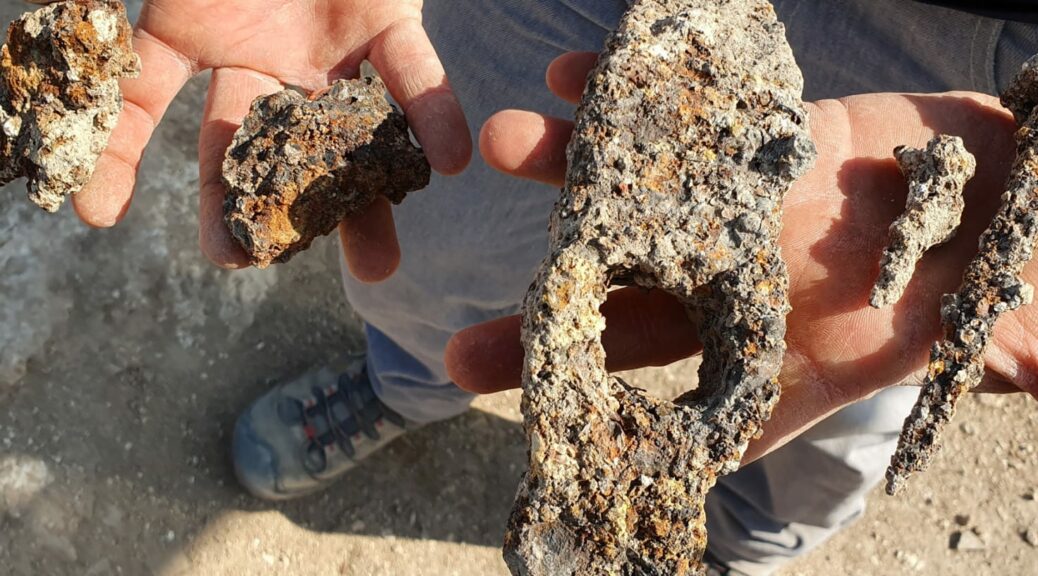1,400-year-old Byzantine Hammer and Nails Discovered in Ancient Jewish Village of Usha
During a Sukkot holiday, some 8,500 individuals were participating in the IAA archeological excavations and activities, but none of them anticipated to discover the most closely associated with building the Sukkah – the hammer and the nails – from the Byzantine period, about 1400 years ago.

This was the luck of a Tur’an family who participated in a Usha dig in the lower Galilee.
“About 20 iron hammers are recorded with the records of the Israeli Antiquities Authority, of which only six are from the Byzantine period,” according to Yair Amitzur and Eyad Bisharat, the directors of the excavation for IAA.
“It is already known that Usha settlers produced large quantities of glass vessels, as we find several wine glasses and glass lamps together with raw material glass lumps, and the discovery of the hammer, nails, and the adjacent iron slag tells us that they also made iron tools on the site.”

Alongside these industries, complex pressing installations for the production of olive oil and wine indicate that the primary occupation and source of income of the Usha inhabitants was the large-scale processing of the agricultural produce of the olive trees and the vines that they cultivated on the surrounding gentle hillslopes.
Adjacent to the oil and winepresses were exposed two rock-hewn ritual baths with plastered walls and steps, dating to the Roman and Byzantine periods, about 1800 years ago.
The discovery of the ritual baths indicates that the Jewish press workers took care to purify themselves in the ritual baths in order to manufacture ritually-pure oil and wine.

The main ‘workforce’ excavating the site are school children, youth and volunteers, who participate in the excavations thanks to the Israel IAA’s policy of bringing the community closer to its own cultural heritage.
Over the past year, more than 15,000 youth and families have taken part in the educational venture at Usha, digging and exposing the fascinating past of the site.
Amitzur also said that the town of Usha had been mentioned in Jewish sources since the first century CE.
“The settlement of Usha is mentioned in the Jewish sources many times in the Roman and Byzantine periods, as the village where the institution of the Sanhedrin was renewed, after the destruction of the Temple in Jerusalem, and after the failure of the Bar Kochba Revolt in 135 CE”.
“The Sanhedrin was the central Jewish Council and Law Court, and it was headed by the President, Rabban Shimon ben Gamliel the Second, who both presided in Usha, and then his son Rabbi Yehudah Hanasi”.
“Here in Usha, the Rabbis of the Sanhedrin made decrees to enable the Jewish people to recover after the war against the Romans, and to reconstruct Jewish life in the Galilee”.

“The Jewish sources mention that Rabbi Yitzhak Nafha was an inhabitant of Usha, and his name ‘Nafha’, meaning ‘the blower’ indicates that he probably worked as a glass manufacturer”.
“The many delicate wine glasses, glass lamps, and glass lumps indicate that Usha inhabitants were proficient in the art of glassblowing. The ritual baths adjacent to the presses indicate that the Sanhedrin Sages paid particular attention to issues of ritual purity”.
The excavations at Usha are part of the Sanhedrin Trail Project that was initiated by the IAA, crossing the Galilee from Bet Shearim to Tiberias, following the movement of the Sanhedrin sages who finally convened in Tiberias.
The excavation is underway, continuing throughout the year with the participation of thousands of school children, youth and volunteers.
Also planned are special activity days open to the general public.
